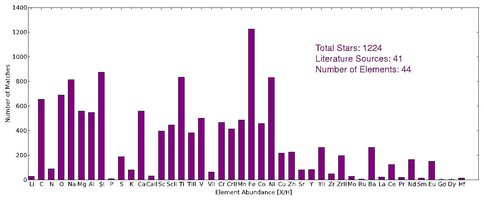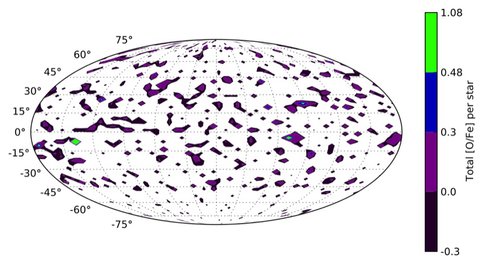2011 Annual Science Report
 Arizona State University
Reporting | SEP 2010 – AUG 2011
Arizona State University
Reporting | SEP 2010 – AUG 2011
Astrophysical Controls on the Elements of Life, Task 7: Update Catalog of Elemental Ratios in Nearby Stars
Project Summary
Future surveys like Kepler for habitable planets will likely be limited to select regions of the sky. In anticipation, we have created the first maps of what the solar neighborhood looks like in the “light” of bio-essential elements such as C, N, O, Si and Fe. To make these maps, we painstakingly compiled and analyzed 25 years’ worth of measured data on 44 chemical elements in 1224 stars that are within 500 light-years of the Sun and potentially host habitable exoplanets. Our new catalog “the Hypatia Catalog“ and the first maps produced from it suggest there are certain directions on the night sky that show enhanced abundances of bio-essential elements. These “habitability hotspots” or “habitability windows” may be of use in current and future searches for Earth-like planets.
Project Progress
We have compiled spectroscopic abundance determinations from literature sources for 44 elements across 1224 stars within 160 pc of the Sun, to produce the Hypatia Catalog. The goal of the Hypatia Catalog is to examine nearby stars and regions in the solar neighborhood for chemical abundance trends, specifically those enhanced with the bio-essential elements C, N, O, Mg, Si, S, and Fe, to aid in the search for habitable exoplanets. Hypatia is based with stellar distances, variability, multiplicity, kinematics, and spectral classification that are consistent with hosting habitable exoplanets. We find the element abundance maps of Hypatia stars suggest: [1] stars in the solar neighborhood are consistent with solar abundances; [2] the evolutionary history of each element is consistent with mean chemical evolution models; [3] there are no significant statistical correlations in the abundances with respect to position, radial distance, or velocity, suggesting the solar neighborhood is well mixed; [4] possible confirmation of trends known to be found in the abundances of verified exoplanet hosts; and [5] there are “habitability windows’” located on the sky at (20 h, -4°) and (22.6h, -48.5°) that exhibit enhanced abundances of bio-essential elements which may be of use in targeted or beamed searches.
Figure 1 – Number of stars in the Hypatia Catalog with measured abundances for 44 different element species. Every catalog that was used in Hypatia contained [Fe/H] determinations, meaning that all 1224 stars have that abundance
Figure 2 – A Mollweide projection of the [O/Fe] ratio for stars in the Hypatia Catalog in RA (horizontal from 0h-24h) and Dec (vertical from [-90° , 90° ]), for a telescope beam area equal to 3°.
-
PROJECT INVESTIGATORS:
-
PROJECT MEMBERS:
Margaret Turnbull
Co-Investigator
Natalie Hinkel
Doctoral Student
-
RELATED OBJECTIVES:
Objective 1.1
Formation and evolution of habitable planets.
Objective 7.2
Biosignatures to be sought in nearby planetary systems


